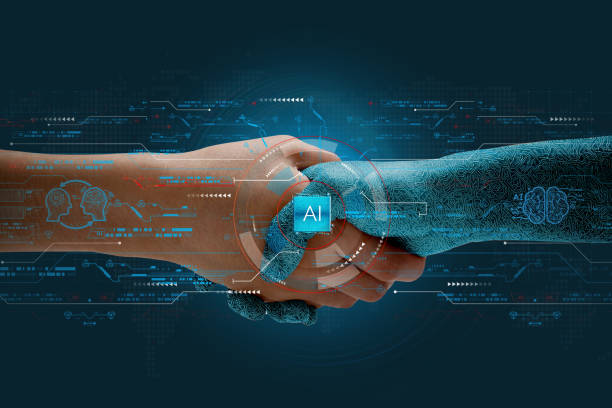Artificial Intelligence (AI) is revolutionizing research by automating tasks, analyzing huge datasets, and identifying patterns that humans might miss. AI processes large amounts of information quickly and accurately, which is crucial for fields like genomics, climate science, and economics.
This allows researchers to focus on innovation and strategic thinking, generating new research ideas for their projects. AI frees up researchers by automating tedious tasks like data collection and cleaning, giving them more time to explore new ideas.
Its predictive capabilities are valuable in areas like epidemiology, finance, and environmental science, where accurate forecasts can save lives and protect the planet. AI research is increasingly important for making these predictions and ensuring responsible use of the technology.
AI also enhances collaboration and personalization in research. Natural Language Processing (NLP) tools help researchers quickly summarize academic papers and stay updated, streamlining the literature review process.
In personalized medicine, for example, AI uses patient data to create tailored treatment plans based on individual genetic profiles and health histories, leading to more effective therapies. However, researchers must carefully assess the potential impact of AI on their scholarly work and research projects.
This includes considering the ethical implications of using AI, ensuring transparency in reporting AI-assisted results and properly attributing contributions from AI in their writing. By taking a proactive and responsible approach to AI in research, we can harness its benefits while mitigating potential risks and challenges.

Understanding AI in Research

Artificial Intelligence (AI)
Artificial Intelligence (AI) involves creating computer systems capable of performing tasks that usually require human intelligence, including learning, problem-solving, and recognizing patterns.
Machine Learning (ML)
Machine learning (ML) is a branch of AI and computer science that centers on developing algorithms enabling computers to learn and improve from experience without explicit programming.
Examples of machine learning include:
- Supervised learning: Training models on labeled data to make predictions or classifications, e.g., spam email detection or image recognition.
- Unsupervised learning: Discovering hidden patterns in unlabeled data, e.g., customer segmentation or anomaly detection.
- Reinforcement learning: Learning through interaction with an environment to maximize a reward signal, e.g., game-playing AI or robotics.
Natural Language Processing (NLP)
Natural Language Processing (NLP) is a tool that deals with the interaction between computers and human language, using AI to enable machines to understand, interpret, and generate human-like text. Examples include:
- Sentiment analysis: Determining the emotional tone of a piece of text, e.g., analyzing customer reviews or social media posts.
- Machine translation: Translating text from one language to another, e.g., Google Translate.
- Text summarization: Generating concise summaries of longer texts, e.g., news article summaries or research paper abstracts.
Importance of AI in modern research practices:
- AI enables researchers to process and analyze vast amounts of data quickly and accurately, leading to faster discoveries and insights.
- AI can help identify complex patterns and relationships in data that might be difficult for humans to detect, enabling researchers to uncover new knowledge and make more informed decisions.
- AI automation reduces the time spent on repetitive and mundane tasks, allowing researchers to focus on higher-level analysis and problem-solving.
- AI enhances the reproducibility and consistency of research findings by minimizing human error and bias.
Examples of successful AI applications in various research fields:
Healthcare and drug discovery:
- AI algorithms can examine medical images to identify diseases such as cancer or Alzheimer's, facilitating earlier diagnoses and improving patient outcomes.
- AI can speed up the process of drug discovery by forecasting the effectiveness and safety of potential drug candidates, thus decreasing both the time and cost involved in developing drugs.
Climate and environmental science:
- AI models can analyze satellite imagery and sensor data to monitor and predict environmental changes, such as deforestation or sea-level rise.
- AI can optimize renewable energy systems by predicting energy demand and supply, helping to reduce greenhouse gas emissions.
Astronomy and astrophysics:
- AI can analyze vast amounts of astronomical data to detect and classify celestial objects, such as galaxies, exoplanets, or gravitational waves.
- AI can help simulate complex cosmic phenomena, such as the formation and evolution of galaxies, providing new insights into the universe's history and future.
Benefits of Using AI in Research

Benefits of Using AI in Research:
- Speed up data analysis, handling large datasets efficiently
- Identifies patterns and insights that human researchers might miss
- Automates repetitive tasks, allowing researchers to focus on high-level analysis
- Enhances accuracy and reproducibility by minimizing human error and bias
- Helps researchers analyze data more effectively, leading to new insights
- AI-powered tools can assist in literature reviews, identifying relevant information from research papers
- Suggest additional terms, or context to consider when answering questions or writing articles
AI offers numerous benefits in research. It enables faster data analysis, handles large datasets efficiently, and identifies patterns and insights that human researchers might miss. AI automates repetitive tasks, allowing researchers to focus on high-level analysis and generating new ideas.
AI-powered tools assist in literature reviews, identify relevant information from research papers, and suggest additional terms, or context to consider when answering questions or writing articles. AI also enhances the accuracy and reproducibility of research findings by minimizing human error and bias.
However, responsible and ethical use of AI in research is crucial. Researchers must consider the limitations and potential biases of AI tools, especially when dealing with sensitive data or generative AI models. Federal agencies are increasingly adopting AI to automate manual processes and improve efficiency, but this raises concerns about detecting AI-generated content.
Researchers should be responsible and use reliable resources and guidelines to ensure research integrity and properly document the use of AI tools, settings, the tool itself, and relevant data and technology sources for transparency and reproducibility.
As AI is a rapidly evolving landscape, researchers must stay informed about the latest developments and best practices. This includes seeking guidance, attending workshops, and collaborating with other researchers and organizations.
Research projects involving AI should carefully consider research questions, data sources, and ethical implications. By leveraging AI responsibly, analyzing data, and doing research projects ethically, researchers can unlock new possibilities, drive innovation, and advance knowledge across various fields.
Free trial
Easily pronounces technical words in any field
Leslie
AI Techniques for Research

Machine Learning (ML)
ML is a subfield of AI that creates algorithms enabling computers to learn and improve from experience without explicit programming. ML techniques are divided into three main categories:
a. Supervised Learning
- Trains models on labeled data for predictions or classifications
- Useful for predicting customer churn, classifying images, or detecting spam emails
- Learns from historical data to predict outcomes for new, unseen data points
b. Unsupervised Learning
- Discovers hidden patterns and structures in unlabeled data
- Valuable for clustering data points, detecting anomalies, or uncovering latent variables
- Helps researchers gain insights and generate hypotheses from complex datasets
c. Reinforcement Learning
- Agent learns to make decisions by interacting with an environment and receiving rewards or penalties
- Useful for optimizing research processes, such as finding best model hyperparameters or designing experiments
- Discovers optimal strategies for complex, sequential decision-making problems
Natural Language Processing (NLP)
NLP deals with the interaction between computers and human language.
a. Text Mining and Sentiment Analysis
- Automatically extracts insights from large volumes of text data
- Assists researchers in efficiently processing and analyzing textual information
b. Named Entity Recognition (NER)
- Identifies and extracts key information, such as names, organizations, and locations, from text data
- Valuable for quickly identifying relevant entities within large corpora of text
Computer Vision Computer Vision software enables computers to interpret and understand visual data, such as images and videos.
a. Image and Video Analysis software
- Analyzes medical images to detect diseases, tracks objects in video streams or, classifies astronomical objects
- Automates visual data analysis, saving researchers time and effort while providing accurate results
- Has numerous applications in medicine, biology, and astronomy
AI techniques like Machine Learning, Natural Language Processing, and Computer Vision offer powerful tools for researchers to analyze data, identify them, uncover insights, identify them, and optimize processes. By leveraging these techniques responsibly, researchers can accelerate discovery and innovation across various fields.
Implementing AI in Your Research Workflow
1. Identifying research problems suitable for AI applications:
Determine if your research problem involves large datasets, complex patterns, or repetitive tasks. Consider whether AI techniques can provide new insights or improve efficiency in your research process. Evaluate the potential impact of AI on your research outcomes and the feasibility of implementation.
2. Collecting and preparing data for AI algorithms:
Gather relevant and high-quality data from reliable sources. Preprocess and clean the data to ensure consistency and remove any errors or outliers.
Label the data appropriately for supervised deep or machine learning tasks or ensure adequate data representation for unsupervised, machine,include or deep learning, only. Split the data into training, validation, and testing sets for model development and evaluation.
3. Choosing the right AI tools and platforms:
Identify the specific AI techniques and algorithms suitable for your research problem. Evaluate available AI tools and platforms based on their performance, ease of use, and compatibility with your data and research environment.
Consider factors such as scalability, customization options, and community support when selecting AI tools. Ensure that the chosen tools and platforms comply with data privacy and security regulations.
4. Collaborating with AI experts or learning AI skills:
Assess your own AI expertise and determine if collaboration with AI experts is necessary. Identify potential collaborators with relevant AI skills and experience in your research domain.
Establish clear communication channels and define roles and responsibilities for effective collaboration with other sources. Alternatively, invest time in learning AI skills through courses, workshops, or online resources to develop in-house AI capabilities.
5. Validating and interpreting AI-generated results:
Regularly validate AI models using appropriate evaluation metrics and techniques. Assess the robustness and generalizability of AI models by testing on independent datasets or through cross-validation.
Interpret AI-generated results in the context of your research problem and domain knowledge. Critically analyze AI models' limitations and potential biases and communicate them transparently in your research findings.
Continuously monitor and update AI models as new data becomes available or research requirements change.
Conclusion
The blog post explores the transformative potential of AI tools in research and guides effectively harnessing its power. It discusses AI techniques like Machine Learning, Natural Language Processing, and Computer Vision, and their applications in various research fields.
The benefits of using AI tools in research are highlighted using AI here, using the use using ai of AI tool can, include faster data processing, handling large datasets, identifying patterns and insights, automating repetitive tasks, and enhancing accuracy and reproducibility.
The importance of the use of AI- responsible and ethical AI implementation in research is emphasized, considering factors such as data quality, bias, transparency, and collaboration with AI experts. Real-world examples demonstrate the successful application using the use of ai- of AI tools in driving innovation and discovery across different research domains.
As AI continues to evolve rapidly, the researcher is encouraged to stay informed about the latest advancements and explore opportunities to incorporate AI into their work. By leveraging AI responsibly and effectively, researchers can unlock new possibilities, tackle complex research problems, and accelerate scientific progress.
The post concludes by emphasizing the transformative role of AI tools in shaping the future of research and the importance of staying informed, aware, adaptable, and committed to responsible AI implementation to unlock new frontiers of knowledge.
Free trial
Easily pronounces technical words in any field




